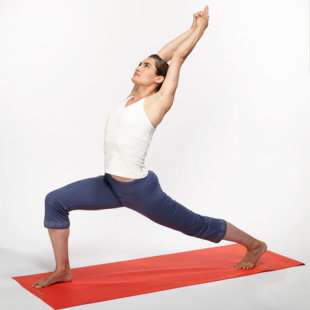
CN Digital Studio

self
The yoga scene is buzzing with claims that the practice will wreck your body. (It seems like only yesterday journals were touting that yoga and stretching were key components to alleviating moderate low-back pain and boosting back function!)
Related: Kristen Bell Answers Your Biggest Health Questions
While it's easy to start pointing fingers, it's important to remember that ultimately you're responsible for preventing injury. It's up to the instructor to develop a safe class and teach proper form, but you have to listen to your body and know when to modify if necessary.
So I turned to anatomy genius Joe Miller for advice. Miller is a senior yoga teacher and teacher training instructor at OM Yoga Center in New York City. Plus, he has an MA in applied physiology and the yoga credential of being an E-RYT 500.
Here's what he had to say:
When you're in yoga class, how do you know if you're pushing yourself too far?
"The obvious clue is if you're feeling pain. Some poses are challenging and require effort, but you shouldn't be in pain. It's also important to practice honesty because it's easy to fool yourself and ignore those signals. If you're saying things like, 'Well, it's not so bad,' or 'I'm sure it's nothing,' or 'I won't be here that long,' that probably means it hurts. Change what you're doing so that it doesn't hurt, or ask your teacher for advice on how to modify the pose."
See more: The Healthiest Cities for Women
What are yoga modifications for common poses that everyone should be aware of?
1. If your hip mobility is limited, elevating your pelvis on a folded blanket or two in seated poses will allow you to upright your pelvis more easily. This will help you avoid slumping, which can stress the lower back.
2. In standing poses, place your hands on blocks if you have difficulty bringing them to the floor.
3. If short hamstrings limit your ability to reach your feet with your hands in forward bends, loop a strap around the arch of the foot and hold the strap with your hands. The strap can help you lengthen your chest forward so that you don't strain your spine by over-rounding your back. This can be done with standing or seated forward bends.
"A one-size-fits-all approach can lead to injury if you try to force your body into some idealized shape. Practicing appropriate modifications allows you to experience the benefits of the practice while keeping yourself healthy," says Miller.
See more: How to Dine Out and Still Lose Weight
What's the easiest way to prevent injury in yoga class?
"It's easy to get distracted by the excitement of keeping up with everybody else in class and ignore the signals your body is sending you. The more you can remind yourself that you're practicing for long-term health and well being rather than short-term results, the more likely you are to listen to the signals that you might be heading towards an injury."
More from SELF:
• 20 Superfoods for Weight Loss
• Yoga Moves for Flat Abs
• 38 Antiaging Foods
• Gwyneth Paltrow's Arm and Ab Workout
No comments:
Post a Comment